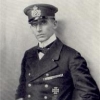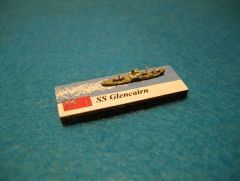Convoy vs Pocket Battleship
Convoy HX2 was heading due west at 9 knots. The Canadian destroyers HMCS Fraser and HMCS Skenna (A class knockoffs) were escorting the convoy and 2,000 yards ahead of it. Commander Wisearse, skipper of Skenna and in command of the convoy’s escort, when asked about the forward deployment of the escort; answered in his best impression of Raul Julio (from “the Gumball Rally) “The first rule of Italian road racing is; what’s behind us, we no worry about.” (Best done with a very heavy fake Italian accent).
The visibility was 24,000 yards and it was not going to get any better. At 1300 hours the masthead reported a ship dead ahead at max visibility. The ship appeared to be heading east and the lookout ventured that it was a pocket battleship. The Commander sourly retorted, “That makes it a Kraut”. The commander immediately signaled the convoy to turn tail and head for Ireland. Of course, immediately is a relative concept when applied to 15 merchantmen (MM) in three columns of 5 ships each. There could no question of the MM turning away together. Nope, it would be a stately evolution in succession at 9 knots. The Canadians would make smoke to cover the evolution of course but that in itself was no guarantee of safety. The Canucks could only hope for a nice, heavy squall in the very near future. Otherwise, it was a long, long way to Tipperary at 9 knots.
One of the Merchantmen radioed Skeena and asked “What’s the Hub, Bub”. The Commander had Signals reply “Pocket Battleship dead ahead”. And remarked, “That ought to stir them a bit.”
Skeena and Fraser tried laying funnel smoke but the Force 3 northwesterly was dispersing it too quickly and the Pocket Battleship (PB) was accelerating towards the convoy. At 1312 hours a series of light squalls reduced visibility 15,000 yards and the Canadians thought their prayers had been answered. But a FP from the PB and the visibility raising to 21,000 yards at 1324 hours dispelled that hope. The DDs went to chemical smoke and evasive movement. The PB opened on Skeena and missed.
At 1330 hours the DDs were not able to cover the port column of MM. the PB hit the Ulster Prince 6 times, sinking her outright. At 1336 hours the PB hit HCMS Fraser 3 times, slowing her to 23 knots. The PB’s secondaries hit the Knight of Malta twice, including a hit to her bridge. At 1336 hours the DDs managed to cover the convoy with smoke for a bit. Who said that smoke is hazardous to your health?
At 1342 hours two destroyers from HX1 (a convoy the PB had sailed past unknowingly), HMCS St. Laurent and Saguenay approached from the west some 21,000 yards behind the PB. They increased speed and headed straight at the PB. The PB hit Neville 3 times, including her bridge and reduced her to 7 knots. The PB also shot at Skeena and missed.
By 1354 hours the Skeena and Fraser had turned back at the PB to engage her and assist the other Canadian destroyers in closing. The PB’s secondaries hit Skeena thrice, including an engine hit that slowed her to 23 knots. The Canadian’s return fire struck the PB amidships and on her quarter deck without noticeable effect. At 1400 hours, The PB’s MB missed Fraser, but her secondaries and tertiaries at 6,000 yards hit Skeena 4 times causing so much damage that she was sinking by 1406 hours (three bulkhead hits will do that).
At 1412 hours Fraser launched both banks of her torpedoes at the PB at about 7,000 yards. At 1418 hours the PB had reversed course when 2 torpedoes struck the PB and immediately sank her. The Canadian destroyers pulled survivors from the water and it was only then that they learned that they had sunk Germany. Herr Hitler upon hearing of KMS Deutschland’s sinking went into a fit and died of an apoplexy. May he roll over in his grave.
This AAR is written from the Allied perspective, but the mistakes are all mine.
WMC










